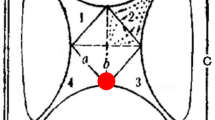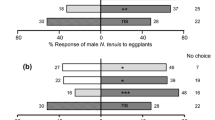Abstract
Flower scents are known as synomones between flowering plants and pollinators, but very little is known about the synomone involving omnivorous predator. Campylomma chinensis Schuh (Hemiptera: Miridae) is an omnivorous predator that feeds on both small soft-bodied arthropods and plant hosts including purple trailing lantana Lantana montevidensis (Spreng.) Briq. (Lamiales: Verbenaceae). In laboratory experiments, we examined the effect of fresh inflorescences and volatiles of L. montevidensis on the behavior of adult C. chinensis. In a Y-tube olfactometer, we found that the fresh inflorescences of L. montevidensis significantly attracted adult C. chinensis. Then, the volatile compounds from the fresh inflorescences of L. montevidensis were analyzed by gas chromatography coupled with mass spectrometry (GC–MS). The results showed that there were seventeen compounds detected in the inflorescences, and the main components were terpenoids including monoterpenoids and sesquiterpenoids. Moreover, the adults were significantly attracted to the concentration of 5 µl/ml farnesol. The results of the present work implied that the omnivorous mirid C. chinensis used farnesol, a sesquiterpenoid alcohol derivative, to identify and locate its plant hosts. The role of farnesol as a potential synomone for C. chinensis is discussed.

Similar content being viewed by others
References
Bengtsson JM, Wolde-Hawariat Y, Khbaish H, Negash M, Jembere B, Seyoum E, Hansson BS, Larsson MC, Hillbur Y (2009) Field attractants for Pachnoda interrupta selected by means of GC-EAD and single sensillum screening. J Chem Ecol 35:1063–1076
Boucher DH (1982) The ecology of mutualism. Ann Rev Ecol Syst 13:315–347
Boucher DH (1985) The idea of mutualism, past and future. In: Boucher DH (ed) The biology of mutualism—ecology and evolution. Crown Helm, London, pp 1–28
Bronstein JL (1994) Conditional outcomes in mutualistic interactions. Trends Ecol Evol 9:214–217
Bronstein JL (2001) The exploitation of mutualism. Ecol Lett 4:277–287
Bruce TJA, Wadhams LJ, Woodcock CM (2005) Insect host location: a volatile situation. Trends Plant Sci 10:269–274
Casado C (1995) Allelopathic effects of Lantana camara (Verbenaceae) on morning glory (Ipomoea tricolor). Rhodora 97:264–274
Croteau R, Karp F (1991) Origin of natural odorants. In: Muller P, Lamparsky D (eds) Perfume: art, science and technology. Elsevier Applied Sciences, New York, pp 101–126
David EW (1999) Cryptic inhabitants of a noxious weed: mites (Arachnida: Acari) on Lantana camara L. invading forests in Queensland. Aust J Entomol 38(3):197–201
Dicke M, Sabelis MW (1988) How plants obtain predatory mites as bodyguards. Neth J Zool 38:148–165
Donaldson JMI, McGovem TP, Ladd TLJ (1990) Floral attractants for cetoniinae and rutelinae (Coleoptera: Scarabaeidae). J Econ Entomol 83:1298–1305
Gao ZZ, Wu WJ, Wu JX, Liang GW (2004) Solid phase micro extraction of the volatile compounds of Lantana camara L. by GC–MC analysis. Chin Tradit Herb Drugs 35(12):1338–1339
Herre EA, Knowlton NU, Mueller G, Rehner SA (1999) The evolution of mutualisms: exploring the paths between conflict and cooperation. Trends Ecol Evol 14:49–53
Hori M (2007) Onion aphid (Neotoxoptera formosana) attractants, in the headspace of Allium fistulosum and A. tuberosum leaves. J Appl Entomol 131(1):8–12
Knudsen JT, Tollsten L, Bergström G (1993) Floral scents: a checklist of volatile compounds isolated by head-space techniques. Phytochem 33:253–280
Lal L (1987) Studies on natural repellents against potato tuber moth (Phthorimaea operculella Zeller) in country stores. Potato Res 30(2):329–334
Laurence AM, Nakahara S, Michael DD (2005) Frankliniella lantanae sp. n. (Thysanoptera: Thripidae), a polymorphic alien thrips damaging Lantana leaves in Australia. Aust J Entomol 44(3):279–283
Lewis WJD, Nordlund A, Gueldner RC, Teal PEA, Tumlinson JH (1982) Kairomones and their use for management of entomophagous insects. XIII: kairomonal activity for Trichogramma spp. of abdominal tips, excretion and a synthetic pheromone blend of Heliothis zea (Boddie) moths. J Chem Ecol 8:1323–1331
Martha RW (1991) Floral colour changes as cues for pollinators. Nature 354:227–229
Mumm R, Hilker M (2005) The significance of background odour for an egg parasitoid to detect plants with host eggs. Chem Senses 30(4):337–343
Nagão T, Abe F, Kinjo J, Okabe H (2002) Antiproliferative constituents in plants 10. Flavones from the leaves of Lantana montevidensis Briq. and consideration of structure-activity relationship. Biol Pharm Bull 25:875–879
Oyedapo OO, Sab FC, Olagunju JA (1999) Bioactivity of fresh leaves of Lantana camara. Biomed Lett 59:179–183
Pellmyr O, Thein LB (1986) Insect reproduction and floral fragrances: keys to the evolution of angiosperms? Taxon 35:76–85
Phillips TW (1997) Semiochemicals of stored-product insects: research and application. J Stored Prod Res 33:17–30
Qin YJ, Wu WJ, Liang GW, Zhang WQ (2002) The Functional response of Campylomma chinesis to Thrips palmi. J South Chin Agric Univ 23(2):27–29
Sahid IB, Sugau JB (1993) Allelopathic effects of lantana (Lantana camara) and siam weed (Chromolaena odorata) on selected crops. Weed Sci 41(2):303–308
Sousa EO, Barreto FSS, Rodrigues FFG, Campos AR, Costa JGM (2013) Chemical composition of the essential oils of Lantana camara L. and Lantana montevidensis Briq. and their synergistic antibiotic effects on aminoglycosides. J Essent Oil Res 24(5):447–452
Tumlinson JH, Turlings TCJ, Lewis WJ (1992) The semiochemical complexes that mediate insect parasitoid foraging. Agric Zool Rev 5:221–252
Vet LEM, Dicke M (1992) Ecology of infochemical use by natural enemies in a tritrophic context. Annu Rev Entomol 37:141–172
Vet LEM, Lewis WJ, Carde RT (1995) Parasitoid foraging and learning. In: Carde RT, Bell WJ (eds) Chemical ecology of insects II. Chapman & Hall, New York, pp 65–101
Vinson SB (1985) The behavior of parasitoids. In: Kerkut GA, Gilbert LI (eds) Comprehensive insect physiology biochemistry and pharmacology, vol 9. Pergamon Press, Oxford, pp 417–469
Visser JH (1986) Host odor perception in phytophagous insects. Annu Rev Entomol 31:121–144
Wu WJ, Yu JY, Liang GW (2003) Feeding habits of mirids. Entomol Knowl 40(2):108–111
Wu WJ, Yu JY, Fu YG, Liang GW (2004a) Analysis on plant hosts and feeding habits of Campylomma chinensis Schuh (Hemiptera: Miridae). Chin J Trop Crops 25(3):61–65
Wu WJ, Yu JY, Fu YG, Liang GW (2004b) Analysis on plant hosts and feeding habits of Campylomma chinensis Schuh (Hemiptera: Miridae). Chin J Trop Crops 25(3):61–65
Wu WJ, Gao ZZ, Yu JY, Liang GW (2005) Roles of olfaction and vision in orientation behavior of adult Campylomma chinensis Schuh (Hemiptera: Miridae) toward lantana plants (Verbanaceae). Chin J Appl Ecol 16(7):1322–1325
Yu JY, Lan CY, Wu WJ, Liang GW (2003) The functional responses of Campylomma chinensis to Bemisia tabaci. J Hubei Agric Coll 23(1):5–7
Yu JY, Wu WJ, Liang GW, Liu XL (2004) Controlling effect of Campylomma chinensis on Aphis gossypii. J South Chin Agric Univ 25(2):60–62
Yu JY, Shen SP, Wu WJ, Ma FM (2005) Releases of Campylomma chinensis (Hemiptera: Miridae) to control pests of egg plant. J South Chin Agric Univ 26(4):27–29
Yu JY, Wu WJ, Liang GW (2012) Population dynamics and migration of Campylomma chinensis Schuh in South China. Chin J Biol Control 28(4):496–501
Yu JY, Wu WJ, Liang GW (2015) Effects of food on development, survivorship and fertility of the omnivorous mirid bug Campylomma chinensis Schuh. Chin J Biol Control 31(4):496–501
Zheng LX, Wu WJ, Liang GW, Fu YG (2013) 3,3-Dimethyl-1-butanol, a parakairomone component to Aleurodicus dispersus (Hemiptera: Aleyrodidae). Arthropod-Plant Interact 7:423–429
Zheng LX, Wu WJ, Fu YG (2014) ±)-2-Hexanol from Pterocarpus indicus leaves as attractant for female Aleurodicus dispersus (Hemiptera: Aleyrodidae). Afr Entomol 22(2):267–272
Acknowledgements
We would like to thank Y-F Chen from the Instrumental Analysis & Research Center of South China Agricultural University for her assistance with GC–MS. This work was supported by the Natural Science Foundation of Guangdong Province, P. R. China (No. 021031).
Author information
Authors and Affiliations
Corresponding author
Additional information
Communicated by William B. Walker III.
Rights and permissions
About this article
Cite this article
Ma, FM., Zheng, LX., Gao, ZZ. et al. Farnesol, a synomone component between lantana (Lamiales: Verbenaceae) and the omnivorous predator, Campylomma chinensis Schuh (Hemiptera: Miridae). Arthropod-Plant Interactions 11, 703–708 (2017). https://doi.org/10.1007/s11829-017-9523-7
Received:
Accepted:
Published:
Issue Date:
DOI: https://doi.org/10.1007/s11829-017-9523-7




